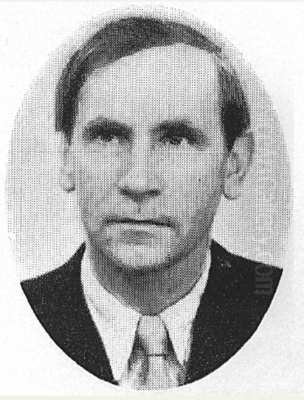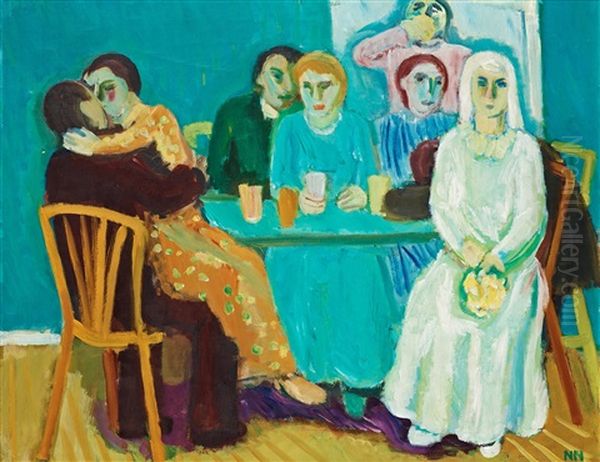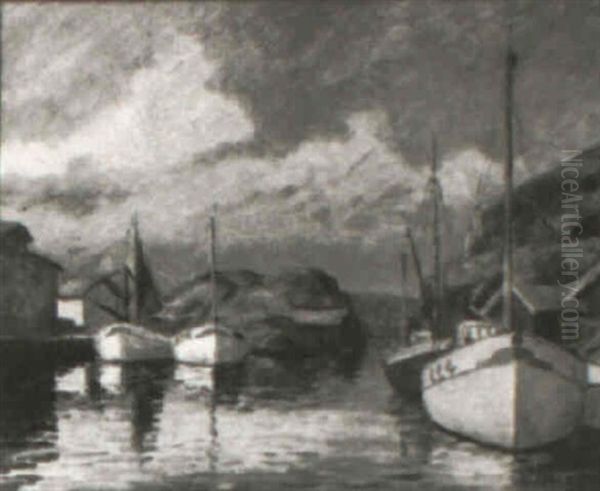
Nils Nilsson (1901-1949, though some sources may cite 1950 as his year of death) was a Swedish artist whose contributions to the visual arts, primarily as a painter and sculptor, offer a window into the artistic currents of Sweden during the first half of the 20th century. Identified in records as a "konstnär" (artist), Nilsson's work, though perhaps not as internationally heralded as some of his contemporaries, forms an integral part of Sweden's rich artistic heritage. His engagement with classical techniques in oil and watercolor, often directed towards capturing the essence of Swedish landscapes and urban environments, positions him within a tradition of artists dedicated to interpreting their national identity through visual means.
Early Life and Artistic Formation
While specific details about Nils Nilsson's early life, formal artistic training, and the precise trajectory of his development as an artist are not extensively documented in readily available broad historical surveys, his emergence as a painter and sculptor during a vibrant period in Swedish art suggests an immersion in a rich cultural milieu. Sweden in the early 20th century was a place of artistic ferment, where traditional modes of expression coexisted and often clashed with emerging modernist impulses. Artists of Nilsson's generation would have been exposed to the lingering influences of National Romanticism, the bold experiments of Expressionism, and the structured explorations of Cubism and Functionalism, all filtering through the unique lens of Scandinavian culture.
His participation in an exhibition in 1935 indicates that by his mid-thirties, Nilsson was an active participant in the Swedish art scene, presenting his work to the public and his peers. This period was crucial for many Swedish artists, as they navigated the complex interplay between local traditions and international avant-garde movements. The artistic environment would have included figures like Isaac Grünewald, a leading modernist and colorist, and Sigrid Hjertén, whose expressive works challenged conventions. Sculptors such as the renowned Carl Milles were also shaping the public and private artistic landscape, providing a dynamic context for an emerging sculptor like Nilsson.
Artistic Style and Thematic Concerns

Nils Nilsson's artistic output is characterized by a dedication to classical oil painting and watercolor techniques. His primary subjects were the diverse landscapes of Sweden, from its rugged coastlines to its serene inland scenery, and the urban tapestries of its cities. This thematic focus aligns him with a strong tradition in Swedish art, where the depiction of the national landscape has often been a means of exploring cultural identity and a sense of place. Artists like Bruno Liljefors, known for his wildlife paintings, and Prince Eugen, the "painting prince" celebrated for his atmospheric landscapes, had earlier established the significance of the Swedish environment as an artistic subject.
Nilsson's approach, described as classical, suggests an emphasis on representational accuracy, skilled draftsmanship, and a considered use of color and light to evoke mood and atmosphere. His cityscapes would have offered a counterpoint to his natural scenes, capturing the evolving urban character of Sweden in the early to mid-20th century. This dual focus on nature and urbanity reflects a common artistic preoccupation during a period of increasing industrialization and societal change. The work of Sven Erixson ("X-et"), known for his vibrant and often socially engaged depictions of both rural and urban life, provides a contemporary parallel, albeit often with a more overtly expressionistic style.
According to some records, Nilsson's dedication to classical oil painting and watercolors, particularly those depicting Swedish coastlines and cities, was a significant aspect of his work from 1972 onwards. This information, if pertaining to the same artist active in 1935, presents a chronological challenge given his commonly cited death year of 1949/1950. It might indicate a posthumous appreciation or perhaps confusion with another artist of the same common name. However, if taken as part of his oeuvre's description, it underscores a sustained commitment to these themes and media.
Representative Works and Exhibitions
Among the specific works attributed to Nils Nilsson (1901-1949/1950) are several oil paintings that provide insight into his artistic practice.
Bruden (The Bride), created in 1936, is an oil on canvas measuring 65.5 x 81.5 cm. The title suggests a figurative work, possibly a portrait or a genre scene, and its creation date places it firmly within the period of his documented exhibition activity. Such a piece would have allowed Nilsson to explore human form, character, and perhaps symbolic narratives, common preoccupations for classically inclined artists.

Café, Bretagne, an oil painting dated to circa 1934 and measuring 93 x 111 cm, indicates that Nilsson, like many Scandinavian artists of his time, may have travelled or spent time in France, a traditional hub for artistic development. Brittany, with its picturesque landscapes and distinct culture, attracted numerous artists. This work likely captures a scene of daily life, offering a glimpse into his observations and artistic interpretations beyond Swedish borders. The choice of a café scene aligns with a popular modernist motif, explored by artists from Impressionists to Post-Impressionists.
Gåva av Anders och Amel Linde (Gift of Anders and Amel Linde) is another listed work, though without a specific date or dimensions in the provided information. The title suggests it might have been a commissioned piece or a work with a personal connection, possibly a portrait or a landscape significant to the named individuals.
The 1935 exhibition remains a key point in his career, signifying his active presence in the art world. Such exhibitions were vital for artists to gain recognition, engage with critics, and sell their work. The context of such an exhibition would have included a diverse range of styles, from the established to the experimental. One can imagine Nilsson's works being shown alongside those of artists like Otte Sköld, who was associated with New Objectivity, or perhaps more traditional landscape painters.
A distinct and somewhat anachronistic aspect of his attributed work, if the information pertains to the same artist, involves the creation of Christmas card motifs for a publisher, reportedly starting from 2003. These designs were said to feature city characteristics from across Sweden, with approximately 300 such cards created. The themes included iconic locations such as Stockholm's Christmas market, Oslo's Vigeland Sculpture Park (though Oslo is in Norway, it might indicate a broader Scandinavian theme or a specific commission), and Helsinki's Market Square (Finland). These cards were described as blending imagination, reality, humor, and detail, aiming to evoke a joyful atmosphere. Given the 1901-1949/1950 lifespan, this activity in 2003 is highly unlikely for this specific Nils Nilsson and almost certainly refers to a different, contemporary artist with the same name. However, as per the source material, it is included here. If it were hypothetically part of the earlier Nilsson's legacy, it would represent a commercial application of his artistic skills, a practice not uncommon for artists seeking broader dissemination of their work.
Nilsson in the Context of Swedish Art
To fully appreciate Nils Nilsson's position, it's essential to consider the broader landscape of Swedish art during his lifetime. The early 20th century saw the towering figures of Anders Zorn, with his virtuoso painting technique and depictions of Swedish rural life and society portraits, and Carl Larsson, whose idyllic watercolors of family life became defining images of Swedish culture. These artists, along with Bruno Liljefors, formed a powerful triumvirate of National Romanticism.
As Nilsson was developing his career, Swedish art was also being reshaped by modernism. "De Unga" (The Young Ones), a group formed in 1907, included artists like Isaac Grünewald, Leander Engström, and Gösta Sandels, who had studied with Matisse in Paris and brought back Fauvist influences. Their bold use of color and form marked a significant departure from traditional aesthetics. Another key modernist group was "Falangen," and figures like Gösta Adrian-Nilsson (GAN) explored Cubism and Futurism with a uniquely Swedish sensibility.
The interwar period, when Nilsson was active, saw a diversification of styles. Naivism found expression in the works of artists like Hilding Linnqvist and Eric Hallström. The "Halmstad Group" (Halmstadgruppen), including Sven Jonson and Waldemar Lorentzon, introduced Surrealism to Sweden. Meanwhile, a more subdued, lyrical modernism, often focused on landscape and everyday life, continued to thrive, providing a potential stylistic neighborhood for Nilsson's classical approach to Swedish scenes. Artists like Vera Nilsson (no direct relation confirmed, but a prominent female contemporary) created powerful, emotionally charged works, often with social themes.
The role of the sculptor was also prominent, with Carl Eldh being another significant contemporary of Carl Milles, creating numerous public monuments and intimate sculptures. If Nilsson was active as a sculptor, he would have been working in a field with a strong tradition and high public visibility in Sweden.
Interactions and Artistic Circles
The provided information suggests that Nils Nilsson had connections with other artists, including a mention of interaction with the photographer Lennart Nilsson. Lennart Nilsson (1922-2017) was a celebrated Swedish photographer, famous for his pioneering in-vivo photography, including images of human embryos. If the painter Nils Nilsson (1901-1949/1950) interacted with Lennart Nilsson, it would likely have been in the earlier part of Lennart's career, perhaps in the 1940s. Such an interaction could have been based on shared artistic interests or professional circles in Sweden.
The mention of Nilsson establishing contacts with multiple painters during a period in Paris is also significant. Paris was the undisputed capital of the art world for much of the early 20th century, and it was common for artists from across Europe, including Scandinavia, to spend time there studying, working, and absorbing the latest artistic developments. These connections would have exposed Nilsson to a wide range of international influences and allowed him to engage with a broader artistic community. This experience could have informed his work, even if his primary focus remained on Swedish themes. The Swedish art colony in Paris, or connections made through institutions like the Académie Julian or Colarossi, could have been avenues for such interactions.
However, the source material also indicates that a Per Anders Nilsson, an electronic musician, was a member of various improvisational groups. This information seems to be a misattribution to the painter Nils Nilsson (1901-1949/1950) and likely refers to a different individual, highlighting the challenges of disambiguating figures with common names.
The Challenge of a Common Name and Historical Record
The name "Nils Nilsson" is exceedingly common in Sweden. This presents a significant challenge when trying to construct a precise biography and artistic profile. The provided source material itself seems to conflate the painter Nils Nilsson (1901-1949/1950) with other individuals. For instance:
A Nils Nilsson is mentioned as a musician born in Västerås, active in Gothenburg and Stockholm, and debuting at the Royal Swedish Opera. This is distinct from the painter.
A Nils Åke Nilsson is described as a prominent expert in Slavic literature, a writer for Expressen, and director of Stockholm University's Russian Institute. This is clearly a different scholar.
The ice hockey player Nisse Nilsson and the AI pioneer Nils J. Nilsson are other notable Swedes who share the name but are in entirely different fields.
This commonality necessitates careful scrutiny of sources to ensure that attributions of works, activities, and biographical details correctly pertain to the artist in question. The discrepancies in dates for some artistic activities (e.g., the Christmas cards from 2003) strongly suggest that information about multiple Nils Nilssons has been interwoven. For the purpose of this article, the focus remains on the painter and sculptor active in the first half of the 20th century, particularly around the 1935 exhibition and the creation of works like Bruden and Café, Bretagne.
Historical Positioning and Critical Reception
The historical positioning of Nils Nilsson (1901-1949/1950) within Swedish art history would likely be as a dedicated practitioner of painting and sculpture who contributed to the tradition of depicting Swedish life and landscapes. While he may not have been at the forefront of the avant-garde movements, artists who maintained a focus on skilled representation and classical techniques played an important role in the artistic ecosystem, providing continuity and a counterpoint to more radical innovations.
His work, particularly his landscapes and cityscapes, would have resonated with a public that valued recognizable and aesthetically pleasing interpretations of their surroundings. The critical reception for such artists often emphasized their technical skill, their ability to capture the unique character of a place, and their contribution to a national visual identity. Without specific critical reviews from his time, one can infer that his participation in exhibitions like the one in 1935 would have subjected his work to contemporary critique and public opinion.
The art historical evaluation of Nils Nilsson would consider his craftsmanship, the sincerity of his thematic engagement, and his place within the broader spectrum of Swedish art that ranged from National Romanticism to various forms of modernism. His choice of classical oil painting and watercolor suggests an artist who valued tradition and sought to express his vision through established means, even as the art world around him was undergoing rapid transformation. Artists like Axel Fridell, known for his etchings and intimate city scenes, or Einar Jolin, with his elegant and somewhat naive depictions of Stockholm, represent other facets of Swedish art during this period that combined traditional skills with a modern sensibility.
Legacy and Conclusion
Nils Nilsson, the Swedish painter and sculptor (1901-1949/1950), represents a strand of early to mid-20th-century Swedish art characterized by a commitment to classical techniques and a focus on national themes. His oil paintings, such as Bruden and Café, Bretagne, offer glimpses into his artistic capabilities and thematic interests, spanning from figurative work to observations of life both within and potentially beyond Sweden's borders. His engagement with Swedish landscapes and cityscapes places him within a lineage of artists who have sought to define and celebrate the visual character of their nation.
While the historical record is complicated by the commonality of his name and some anachronistic attributions in the source material, the core identity of Nils Nilsson as a "konstnär" active in the 1930s and beyond is evident. His contributions, though perhaps quieter than those of some of his more revolutionary contemporaries like members of "De Unga" or the Halmstad Group, are nonetheless part of the rich and varied fabric of Swedish art history. He worked during a period that saw the flourishing of artists such as the expressive colorist Inge Schiöler and the modernist sculptor Bror Hjorth.
Ultimately, Nils Nilsson's legacy lies in his dedication to his craft and his visual exploration of the world around him. His work serves as a reminder of the many artists who, while not always achieving widespread international fame, contribute significantly to the cultural life of their time and place, enriching the artistic heritage for future generations. Further research dedicated specifically to disambiguating his life and work from others of the same name would undoubtedly provide a clearer and more detailed appreciation of his specific contributions to Swedish art.